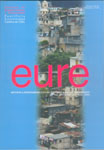Residencial segregation in Latin-America city
DOI:
https://doi.org/10.4067/S0250-71612004008900001Keywords:
migration, poverty, urban policy, segregationAbstract
In spite of the growing relevance of the socioeconomic residential segregation (SRS) in academic debates and public agendas in Latin American and the Caribbean, the evidence regarding its intensity and magnitude, its tendencies, its reproductive mechanisms and consequences, is fragmentary and weak. Moreover there is little work on comparative indicators of socioeconomic residential segregation between countries (or even in a diachronic way for each country). In this regard, this document offers some pieces of empiric evidence about this social phenomenon, focused in Latin America cities. It aims to contribute in four directions: (a) to advance in the measurement of the SRS in the countries of the region; (b) to study its determinants, especially the intra-metropolitan migration patterns; (c) to explore disparities in behavior and life conditions between rich and poor areas, as first step for the study of the consequences of the SRS; (d) to revise and to analyze policy options considering the international experience.Metrics
Downloads
Published
How to Cite
Issue
Section
License
Copyright (c) 2004 Revista EURE - Revista de Estudios Urbano Regionales

This work is licensed under a Creative Commons Attribution 4.0 International License.
Al momento de aceptar la publicación de sus artículos, los autores deberán formalizar la cesión de derechos de autor a EURE, según las condiciones establecidas por la Revista.
Ésta establece que el autor autoriza a EURE de manera gratuita, exclusiva e ilimitada a reproducir, editar, publicar, distribuir, publicitar, comercializar y traducir el artículo, a cualquier soporte conocido o por conocer y desarrollar.
Del mismo modo, los autores aseguran que el artículo propuesto es original, no publicado y no propuesto para tal fin a otro medio de difusión.


